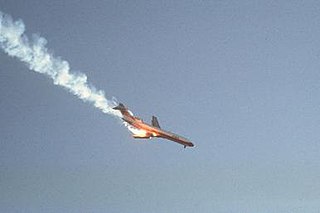
Pacific Southwest Airlines (PSA) Flight 182 was a scheduled flight of Pacific Southwest Airlines from Sacramento to Los Angeles and San Diego. On September 25, 1978, the Boeing 727-214 serving the flight, registration N533PS, collided with a private Cessna 172 light aircraft, registration N7711G, over San Diego, California. It was Pacific Southwest Airlines' first fatal accident, and it remains the deadliest air disaster in California history. At the time, it was the deadliest air crash in American history, and would remain so until American Airlines Flight 191 in May 1979.

Delta Air Lines Flight 1141 was a scheduled domestic passenger flight between Dallas/Fort Worth, Texas and Salt Lake City, Utah. On August 31, 1988, the flight, using a Boeing 727-200 series aircraft, crashed during takeoff, resulting in 14 deaths and 76 injuries of the 108 on board.
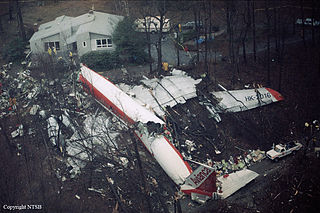
Avianca Flight 052 was a regularly scheduled flight from Bogotá, Colombia, to New York City, United States, via Medellín, Colombia, that crashed on January 25, 1990, at 21:34 (UTC−05:00). The Boeing 707 flying this route ran out of fuel after a failed attempt to land at John F. Kennedy International Airport (JFK), causing the aircraft to crash onto a hillside in the small village of Cove Neck, New York, on the north shore of Long Island. Eight of the nine crew members and 65 of the 149 passengers on board were killed. The National Transportation Safety Board (NTSB) determined that the crash occurred due to the flight crew failing to properly declare a fuel emergency, failure to use an airline operational control dispatch system, inadequate traffic flow management by the Federal Aviation Administration (FAA), and the lack of standardized understandable terminology for pilots and controllers for minimum and emergency fuel states.

United Airlines Flight 585 was a scheduled passenger flight on March 3, 1991, from Denver to Colorado Springs, Colorado, carrying 20 passengers and 5 crew members on board. The plane experienced a rudder hardover while on final approach to runway 35 at Colorado Springs Municipal Airport, causing the plane to roll over and enter an uncontrolled dive. All 25 people on board were killed.

On the evening of February 1, 1991, USAir Flight 1493, a Boeing 737-300, collided with SkyWest Airlines Flight 5569, a Fairchild Swearingen Metroliner turboprop aircraft, upon landing at Los Angeles International Airport (LAX). Though air traffic was not heavy at LAX, as Flight 1493 was on final approach, the local controller was distracted by a series of abnormalities, including a misplaced flight progress strip and an aircraft that had inadvertently switched off the tower frequency. The SkyWest flight was told to taxi into takeoff position, while the USAir flight was landing on the same runway.
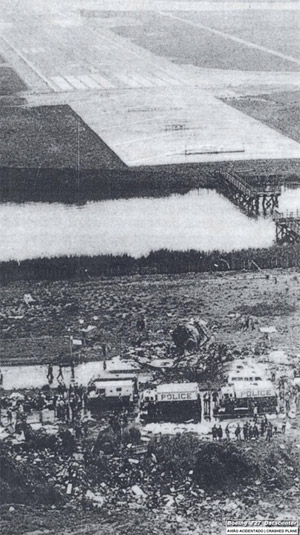
Eastern Air Lines Flight 66 was a regularly scheduled flight from New Orleans to New York City that crashed on June 24, 1975 while on approach to New York's John F. Kennedy International Airport, killing 113 of the 124 people on board. The crash was determined to be caused by wind shear caused by a microburst, but the failure of the airport and the flight crew to recognize the severe weather hazard was also a contributing factor.

Juneau International Airport is a city-owned, public-use airport and seaplane base located seven nautical miles northwest of the central business district of Juneau, a city and borough in the U.S. state of Alaska that has no direct road access to the outside world. The airport serves as a regional hub for all air travel, from bush carriers to major U.S. air carriers such as Alaska Airlines.

United Air Lines Flight 553 was a scheduled flight from Washington National Airport to Omaha, Nebraska, via Chicago Midway International Airport. On December 8, 1972, the Boeing 737-222 serving the flight, City of Lincoln, registration N9031U, crashed during an aborted landing and go around while approaching Midway Airport.

United Airlines Flight 389 was a scheduled flight from LaGuardia Airport, New York City, New York, to O'Hare International Airport, Chicago, Illinois. On August 16, 1965, at approximately 21:21 EST, the Boeing 727 crashed into Lake Michigan 20 miles east of Fort Sheridan, near Lake Forest, while descending from 35,000 feet (11,000 m) mean sea level (MSL). There was no indication of any unusual problem prior to impact. All 30 persons aboard, including six crew members and 24 passengers, were killed.

American Airlines Flight 383 was a nonstop flight from New York City to Cincinnati on November 8, 1965. The aircraft was a Boeing 727, with 57 passengers, and 5 crew on board. The aircraft crashed on final approach to the Cincinnati/Northern Kentucky International Airport located in Hebron, Kentucky, United States. Only three passengers and one flight attendant survived the crash.

Piedmont Airlines Flight 22 was a Piedmont Airlines Boeing 727-22 that collided with a twin-engine Cessna 310 on July 19, 1967, over Hendersonville, North Carolina, United States. Both aircraft were destroyed and all passengers and crew were killed, including John T. McNaughton, an advisor to U.S. Secretary of Defense Robert McNamara. The aircraft were both operating under instrument flight rules and were in radio contact with the Asheville control tower, though on different frequencies. The accident investigation was the first of a major scale conducted by the newly created National Transportation Safety Board. A review of the investigation conducted 39 years after the crash upheld the original findings that had placed primary responsibility on the Cessna pilot.

Gol Transportes Aéreos Flight 1907 was a scheduled domestic passenger flight from Manaus, Brazil, to Brasília and Rio de Janeiro. On 29 September 2006, the Boeing 737-800 operating the flight collided with an Embraer Legacy 600 business jet over the Brazilian state of Mato Grosso. The winglet equipped wingtip of the Legacy sliced off about half of the 737's left wing, causing the 737 to break up in midair and crash into an area of dense jungle, killing all 154 passengers and crew. Despite sustaining serious damage to its left wing and tail, the Legacy landed with its seven occupants uninjured.
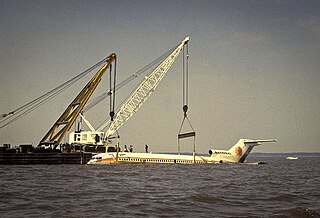
National Airlines Flight 193, registration N4744, Donna, was a Boeing 727-235 en route from Miami, Florida to Pensacola on May 8, 1978. It was scheduled with stops at Melbourne, Florida; Tampa; New Orleans, Louisiana and Mobile, Alabama. The accident occurred at night in low visibility from fog. During the descent into Pensacola Regional Airport it impacted Escambia Bay, sinking in 12 feet (3.7 m) of water.

TWA Flight 841 was a scheduled passenger flight from John F. Kennedy International Airport in New York City, en route to Minneapolis-Saint Paul International Airport in Minneapolis, Minnesota. On April 4, 1979, at or around 9:48 p.m. Eastern Standard Time, while flying over Saginaw, Michigan, the Boeing 727-31 airliner began a sharp, uncommanded roll to the right, and subsequently went into a spiral dive. The pilots were able to regain control of the aircraft and made a successful emergency landing at Detroit Metropolitan Airport.
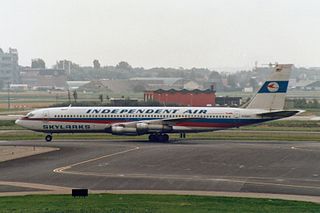
On 8 February 1989, Independent Air Flight 1851, a Boeing 707 on an American charter flight from Bergamo, Italy, to Punta Cana, Dominican Republic, struck Pico Alto while on approach to Santa Maria Airport in the Azores for a scheduled stopover. The aircraft was destroyed, with the loss of all 144 people on board, resulting in the deadliest plane crash in Portugal's history. All of the passengers on board were Italian and all of the crew were Americans. The crash is also known as "The disaster of the Azores".

Northwest Orient Airlines Flight 6231 was the fatal crash of a Boeing 727 in the eastern United States on December 1, 1974 in Harriman State Park near Stony Point, New York, just north of the New York City area. The Northwest Airlines 727 had been chartered to pick up the Baltimore Colts professional football team in Buffalo in western New York.

Delta Air Lines Flight 723 was a flight operated by a McDonnell Douglas DC-9 twin-engine jetliner, operating as a scheduled domestic passenger flight from Burlington, Vermont, to Logan International Airport in Boston, Massachusetts, with an intermediate stop in Manchester, New Hampshire. On July 31, 1973, at 11:08 a.m., while on an instrument landing system (ILS) instrument approach into Logan in low clouds and fog, the aircraft descended below the glidepath, struck a seawall, and crashed. The incident killed all 89 occupants; two people initially survived, but later died of their injuries.

Ryan International Airlines Flight 590 was a cargo flight carrying mail for the United States Postal Service from Greater Buffalo International Airport (BUF) in Buffalo, New York, to Indianapolis International Airport (IND) in Indiana, with a stopover at Cleveland Hopkins International Airport (CLE) in Cleveland, Ohio. On February 17, 1991, the McDonnell Douglas DC-9-15RC operating the flight crashed on takeoff from Cleveland during icing conditions. Both pilots, the aircraft's only occupants, were killed. The National Transportation Safety Board (NTSB) determined that the causes of the crash were the flight crew failing to deice their aircraft, and the inexperience of the Federal Aviation Administration (FAA), McDonnell Douglas, and Ryan International Airlines with icing condition on DC-9-10 aircraft.

On 23 December 1983, Korean Air Lines Flight 084 (KAL084), a McDonnell Douglas DC-10-30 performing a cargo flight, collided during its takeoff roll with SouthCentral Air Flight 59 (SCA59), a Piper PA-31-350, on runway 06L/24R at Anchorage International Airport, as a result of the KAL084 flight crew becoming disoriented while taxiing in dense fog and attempting to take off on the wrong runway. Both aircraft were destroyed, but no fatalities resulted.

The crash of Alaska Airlines Flight 60 was an accident involving a Boeing 727-81 of the American airline Alaska Airlines at Ketchikan International Airport in Ketchikan, Alaska, United States, on April 5, 1976, resulting in the death of a passenger with 32 serious and 17 minor injured survivors among the initial 50 passengers and crew on board.




















